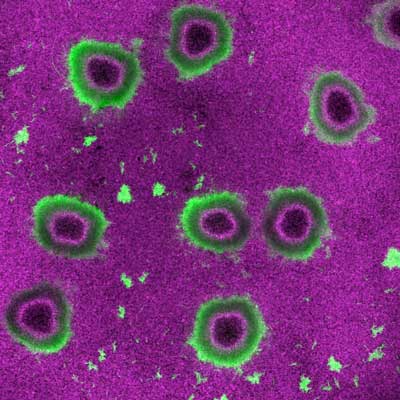| Oct 13, 2020 |
Mechanical forces of biofilms could play role in infections
|
|
(Nanowerk News) The vast majority of bacteria in the world live on surfaces by forming structures called “biofilms”. These communities host thousands to millions of bacteria of different types, and are so biologically complex and active that scientists describe them as “cities”.
|
|
Biofilms are in fact the preferred lifestyle of bacteria. They form them by attaching to each other on surfaces as diverse as the oceanfloor, internal organs and teeth: dental plaque is a common example of a biofilm. But biofilms also cause chronic infections, e.g. the opportunistic pathogen Pseudomonas aeruginosa that forms biofilms in the lungs of cystic fibrosis patients.
|
 |
| Confocal visualization of V. cholerae biofilms deforming a soft hydrogel substrate with embedded fluorescent particles. (Image: Alice Cont) (click on image to enlarge)
|
|
Generally speaking, the interaction between biofilm and host is thought to be biochemical. But there is some evidence to suggest that the physical, mechanical interplay between them might be just as important – and overlooked as an influence on the host’s physiology. For example, how do biofilms form on soft, tissue-like materials?
|
|
This is the question that a team of scientists led by Alex Persat at EPFL have ventured to answer. Publishing in the journal eLife ("Biofilms deform soft surfaces and disrupt epithelia"), they show that biofilms of two major pathogenic bacteria, Vibrio cholerae and Pseudomonas aeruginosa, can cause large structural deformations on soft materials like hydrogels.
|
|
When bacteria form biofilms, they attach onto a surface and begin to divide. At the same time, they bury themselves inside a mix of polysaccharides, proteins, nucleic acids, and debris from dead cells. This mix forms a sticky substance that is called the “EPS” matrix (EPS stands for “extracellular polymeric substances”).
|
|
As single bacteria grow inside the EPS they stretch or compress it, exerting mechanical stress. The growth of the biofilm and the EPS matrix’s elastic properties generate internal mechanical stress.
|
|
The scientists grew biofilms on soft hydrogel surfaces and measured how they exerted forces upon variations of EPS components. This revealed that biofilms induce deformations by “buckling” like a carpet or a ruler. How big the deformations are depends on how stiff the “host” material is and on the composition of the EPS.
|
|
The researchers also found that V. cholerae biofilms can generate enough mechanical stress to deform and damage soft epithelial cell monolayers, like those that line the surface of our lungs and intestines. What this means is that the forces generated by growing biofilms might mechanically compromise the physiology of their host. In short, biofilms could promote a “mechanical” mode of infection, which might warrant a whole new approach to treatments.
|

